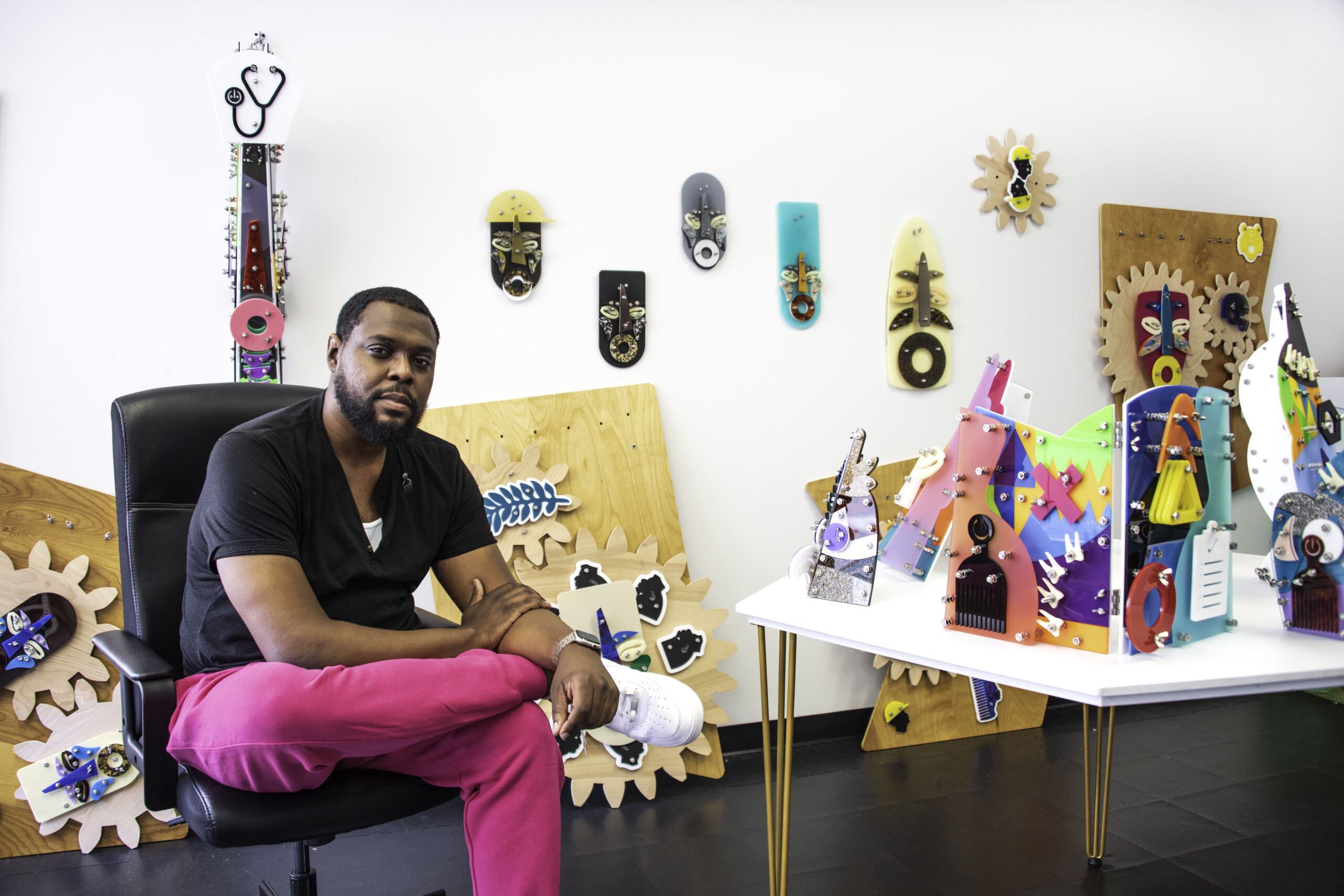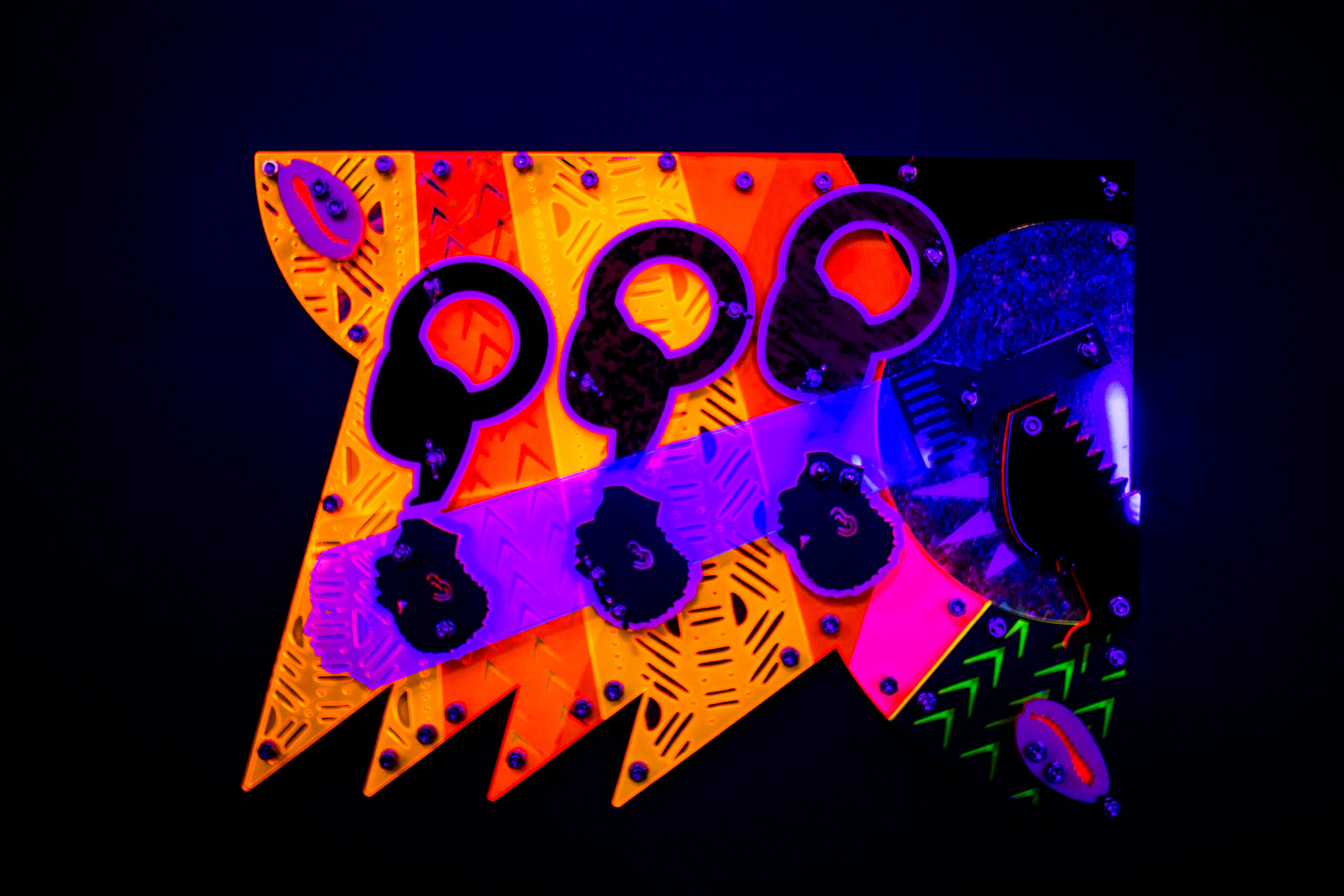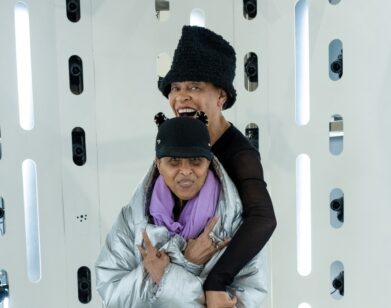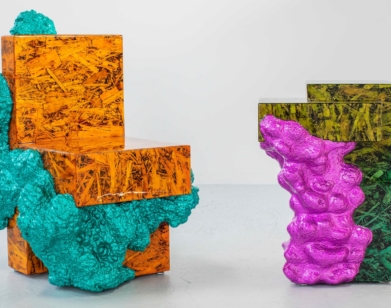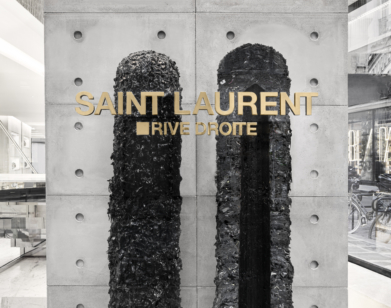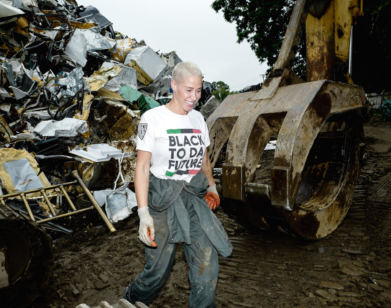IN STUDIO
Meet Damien Davis, the Sculptor Who is “Laying the Trap”
Perhaps the bright colors and inventive structure of Damien Davis’s sculptures have caught your eye in a museum or gallery. Perhaps you’ve walked up to them, admired the Brooklyn-based artist’s work, and been pleased by the symphony of hues and shapes he evokes using laser-cut acrylics. But then you saw your reflection in the plastics he frequently uses in his work, you looked closer, and identified the themes at work via imagery including silhouettes of Nefertiti, pick combs, watch gears, and West African masks: racial injustice, police brutality, inequality, and the demonization of queer communities. And still, your reflection, in the cheery colors that caused you to draw near, holds your gaze. What role do you play in these realities of American life? And will you engage with what you saw, or will you walk away?
Davis, who was raised in Arizona and works as a Visiting Assistant Professor of Sculpture at Purchase College (SUNY), calls this “laying the trap.” His most recent exhibition, held at the Project for Empty Space in Newark, was titled SEARCHING., and explored these themes through sculpture that is held together without screws or glue. The tension Davis creates between his many components holds his work together, and this may or may not be a larger commentary on what holds us, as a society, together too. Shortly after the show opened, he and I spoke about our own experiences with bigotry, our creative channels, and shared a few choice words about our mutual alma mater, New York University.
———
DAMIEN DAVIS: So wait, what did you study at NYU?
NANDINI BALIAL: I went from journalism to English to Tisch for cinema studies. I was very interested to read about your time at NYU because it reminded me of how I felt when I was there. It’s so white.
DAVIS: Which is wild because you would expect a school situated in the middle of New York City to feel like New York City. I don’t think NYU was always like that. I was strongly encouraged by my mentor growing up in Phoenix to come to NYU because he had been a professor there, I think back in the ’80s. If he were still alive, he’d be probably 105 or so. He was a protege of all these Harlem Renaissance painters. So I definitely thought the experience would be radically different.
BALIAL: When you went there for your MFA, you’ve talked about how it taught you the sides of art they don’t actually teach you in art school proper—selling your work, turning yourself into a presence.
DAVIS: It’s an MA in visual arts administration. The conversations that were had in grad school were very sobering to the reality of the art world, or at least the commercial side of it. When you’re a student still committed to this romantic idea of what being an artist is supposed to look like, those other parts of it could sometimes be hard to grasp. I let my undergrad experience in art school convince me that I didn’t have what it took to be a successful artist because I was in these very white, cis, straight spaces where I was always the other. And instead of having substantive conversations about the work, it was always me explaining or defending my existence. It became about me controlling the narrative around my work, managing sales professionally, stuff like that. It’s been a gift in a lot of ways, one that I try to share with other artists as best I can.
BALIAL: I’m happy to hear because it’s usually artists of color who would lose out more if they didn’t know those things.
DAVIS: The art world conditions artists to believe that it’s more competitive than it actually is. There’s this scarcity idea for artists of color to sell or exhibit at a certain level as well. And by sharing our expertise we’re somehow undercutting our own ability to succeed. To me, I don’t know, that’s like some deep colonial imperialist, anti-Black—
BALIAL: Bullshit? Yeah.
DAVIS: —thinking that I don’t want to be a part of it at all. We can lift each other up.
BALIAL: I read that you were a Lego kid. Is there some part of you that enjoys the freedom of not having a map and being the only one with the image in your head?
DAVIS: Yeah, because of the nature of the materials I work with. Some elements don’t easily facilitate this purely instinctive approach. It’s not traditional painting where you can just decide where to stop. I have to have a plan. I have to know how much material I need, plot out the holes for the hardware, how everything fits together. I don’t use glues or adhesives. Everything is just held together with the tension of the hardware. So there’s always this planning stage when I’m trying to make sure that I’m engineering the thing to be structurally sound and hold itself together. I always say to people that being a Lego kid inadvertently became the training for the way that I make my work now. When my parents would buy me a Lego set, they would challenge me to assemble it without using the instructions.
BALIAL: Oh, wow.
DAVIS: Yeah, so I got very good at looking at a two-dimensional image and imagining it in three-dimensional space.
BALIAL: What a great way to train your mind.
DAVIS: The way that I like to make objects resists traditional ways we romanticize art-making. So for some people, it feels very foreign or maybe cold or overly engineered, but I like stirring that in a viewer.
BALIAL: I was just listening to an interview of yours where you talked about what you like to call “laying the trap.” You use these reflective surfaces with acrylics in your work, so someone might walk up to it like, “Oh, what a pretty color,” but then they see their face reflected back at them in a form that may cause them to question themselves in some way.
DAVIS: I don’t want the read to be too immediate with anything that I make. But I am fascinated with the works functioning as Trojan horses where a viewer falls in love with their own reflection in the shininess and color of the hardware, and at least at first blush, [is] not interrogating the shapes and imagery as intensely. It’s only after they’ve been seduced by the materials that they start to question what they’re looking at. And that’s where I get to pull the lever to the trap door like, “Oh, no, I’m falling. Now I can talk about institutional racism.”
BALIAL: People don’t like being interrogated about their prejudices. I assume that you’ve experienced that in Louisiana and Arizona as well.
DAVIS: Growing up in Phoenix, my family would road trip to Louisiana and we would always spend a full day in Texas. And my parents were always insistent on going to these random diners on the side of the road, and we would walk in and they wouldn’t seat us or let us go to the bathroom. That hyper-awareness of the body while navigating public spaces has always been at the forefront of my mind. Both of my parents had to integrate their small-town high school in Louisiana.
BALIAL: Yeah, I read about how they were the first.
DAVIS: My father passed away a while back, but those experiences obviously inform the way a person navigates the world. And then if they’re charged with raising a black son who is physically larger than the other kids his age, they have to deal with the way I’m received as an adult. I wasn’t allowed to wear a shirt without a collar growing up. I wasn’t allowed to wear ripped jeans, hoodies, things like that. Growing up, I was the kid that would score the highest on every test in class. I was the kid that skipped a grade. But because I was physically bigger than the other kids, everyone would assume that I got held back. I’ve only recently started thinking about how that upbringing has affected my work, using laser cutters and vector software, part of me is starting to wonder if it might just boil down to a performance of my own intelligence. Because I’ve always felt like I had to over-perform for a world that wants to see me as something else. I’m in a weird place.
BALIAL: Do you feel that spectators are seeing what you go through making that work?
DAVIS: I’m mindful of the types of audiences that are going to encounter the work. There are two primary audiences that are at the forefront of my mind when I’m making something. There are the people that are well-versed in museum spaces and need to be tricked into talking about things that challenge their worldview, and there’s an audience that doesn’t think galleries and museums are for them because they either grew up without access to them or haven’t seen themselves reflected in the work. If you’re someone that’s not necessarily comfortable walking into these spaces, you might say, “Oh, I know what that shape is,” and you can start building a conversation.
BALIAL: That’s important. I was looking at your quilting work, and it’s like you’re speaking through the quilt, you’re talking about something very specific.
DAVIS: There’s a long history of quilting for African Americans specifically. I come from a family of quilters on my mother’s side, and there’s a long and contested history of quilting being used as a tool during enslavement to communicate messages for people looking to obtain freedom, ideas that needed to be kept secret for people’s safety. Even if it’s not always fabric and thread, sometimes it’s acrylic and hardware. It’s the idea of quilting together a narrative that might feel coded.
BALIAL: That makes perfect sense. Going through your work, the motif of the pick comb is in several of your pieces, but you sometimes use the computer power logo in place of it. Why did you link that symbol to a pick comb?
DAVIS: I like to think that the work is participating in Afrofuturist conversations. I don’t know if I see myself as someone who’s firmly part of an Afrofuturist movement, but I think a lot about the way technology impacts Black folks’ control and autonomy. For that particular shape, I just love the idea that the iconic image of the Afro pick with the fist on the top, a representation of power, gets transformed into a power button. That opens up a conversation about the different ways that power can manifest itself, especially when we talk about digital spaces.
BALIAL: I call it Hitchcocking yourself, but it looked like you were waving to yourself a bit in “On the Grind.” Was that you?
DAVIS: I guess so. Anything with a dick in it is brand new to that show because this is the first time I’ve allowed myself to overtly deal with queer themes in the work. In that piece, I’m thinking about a relationship that’s been brokered entirely online between two men who are total strangers. So this overweight, red torso figure overshadowing this other shape came from a narrative standpoint on how fucked up those spaces are. The show overall deals with this idea of whether Black folks have autonomy in domestic spaces, especially when you look at stories like Breonna Taylor. But also the devil you potentially invite into your home for the sake of love and affection. So in a weird way, I see myself as both figures, the one that’s overpowering and the one that’s vulnerable. You’re the first person to ask me this.
BALIAL: I hope that’s a good thing.
DAVIS: It’s forcing me to think.
BALIAL: The best kind of art seems to come from that internal interrogation. And to some degree, it doesn’t belong to you, right? When people walk through a gallery, they will have their own view.
DAVIS: Yeah, absolutely. Hopefully, it’s uncomfortable, but hopefully, it’s also thought-provoking or eye-opening. Part of me is like, “Let’s just unpin the grenade and see what happens.”
BALIAL: So this upfront exploration of Black queer sexuality is newer in your work. How does that feel? Because I assume it’s not received the same in New York as back home in Arizona.
DAVIS: I do strongly believe that New York is a bubble where we get to exercise privileges that don’t exist in most of the rest of the world or the country. I don’t necessarily have to worry about my own personal safety as much as other more obviously queer-coded people do. For me, that fact has always manifested itself as a responsibility to protect other people. Older generations of queer folk, we had to become really good at assessing our surroundings extremely quickly for the sake of our own survival. And I don’t think that that has ever stopped for me. This is going to sound bad. You’re asking me questions that are fucking with me.
BALIAL: Sorry.
DAVIS: It’s a good thing though. You’re asking things that a lot of other people who write about art might not want to ask me, so thank you for that.
BALIAL: I’m an immigrant. I’m from India and I grew up in quite possibly the most racist environment my parents could have found for us in this country. So I’ve never lost sight of that kind of solidarity. I was joking with my dearest friend from NYU, Esther, who’s from Ghana, that whenever we go into a public place we automatically track how many people of color are around as a safety thing.
DAVIS: But we have to. And being Black and queer, it might be a generational thing, because the thought of being respected by a mainstream straight community never even entered our minds. It was about creating spaces where we could be free and unburdened. The idea that the world could be that space was maybe a little too radical back then.
BALIAL: Yeah. I’m heartened that Gen Z just gives zero fucks. They’re like, “This is who I am, and if you don’t like it, then bye.”
DAVIS: They’re pushing back. But the idea of not having a space where you feel at home is exhausting. You’re always the outlier. As we come out of this period of isolation, maybe it’s easier to have this conversation about how queerness and loneliness are intertwined for a lot of older queer folk. I’m trying to embrace me being old.
BALIAL: You’re not old. I’m sorry, we’re not there yet. But I like Gen Z’s attitude. I hope they use it to hold people’s feet to the fire and push for more change than we were able to. We were too busy paying student loans.
DAVIS: That part.
BALIAL: I wanted to ask about Blackamoors, which you’ve researched. It depressed me to learn that they’re like lawn jockeys for Europe. It’s considered an art form and maybe not everyone who has it is violently racist, but it’s fine to them.
DAVIS: Yeah, it’s so pervasive that people might think that they aren’t implicated in the problematic elements it’s born out of. I also know that Blackamoors are different from blackface in the U.S. because a lot of it is born out of fetishization. It’s not necessarily as politically motivated as some of the imagery created of Black people in the United States. So part of my work is about understanding those nuances and separating myself emotionally.
BALIAL: It’s tricky because you’re exploring another culture hopefully, but the prejudice just manifests itself differently. In Hinduism, when you’re having bad luck, it’s said to be the work of Shani, who has black skin. And when he looks upon you, that’s when everything goes wrong.
DAVIS: I didn’t know that.
BALIAL: Yeah, it’s wild because as a child, I would hear this story and as I got older, I was like, “That’s racist. That’s fucked.”
DAVIS: That’s heavy.
BALIAL: In India in general, the same colorism exists. Girls are told all their lives, “Be sure you have fair skin or you won’t get a husband,” and South Indians are looked down upon because they have darker skin.
DAVIS: I remember freshman year at NYU Weinstein Hall, I’m riding up the elevator with these two Asian girls and one of them literally said as I’m standing there in the elevator, “I don’t want to be standing out in the sun too long because I don’t want to look like a rice farmer.” I was standing there like, “Wow, I guess I’m just farming all the rice, huh?”
BALIAL: You’re the rice kingpin.
DAVIS: It’s so pervasive. Americans also have this very particular way of talking about racism because we experienced the transatlantic slave trade, but unlike all the other countries, the enslaved people didn’t outnumber those subjugating them. So we were never able to self-actualize the way that a lot of the Caribbean countries or South American countries were able to.
BALIAL: A friend of mine who’s a community organizer in North Carolina likes to say that the day working-class white people figure out that they have more in common with people of color than they do with rich white people, we will be unstoppable. There’s no version of opening the news on a daily basis where you feel good about what’s going on. How do you find joy?
DAVIS: I get a lot of satisfaction out of creating the work. This might sound a little sad, but I don’t know if I necessarily center my own life’s work around finding my own joy.
BALIAL: That’s really interesting. Why do you say that?
DAVIS: Well, there are a lot of conversations now about self-care and centering your own comfort and that’s great. But part of me also wonders—and maybe it’s not a zero-sum game—if it’s more important to work towards a future where a next generation is a little bit more free. I don’t think that’s going to happen in my lifetime. I’m not having children, but maybe my spiritual grandchildren will get to experience that. It’s like climate change. We’ll probably die off before shit gets really real, but we can recycle that plastic now.
BALIAL: My last question, and I ask this of everyone I interview. How did the pandemic, if it did, and all the loss it caused, have an effect on your art and psyche as an artist?
DAVIS: I find myself less interested in working myself to the bone the way that I used to. I used to work until 1:00 in the morning, go home, crash and do it all over again. I don’t take it for granted anymore that I’m going to be around tomorrow, so I treat every conversation like it’s the last one.
BALIAL: That’s lovely.
DAVIS: Edibles helped, too. I discovered it during the pandemic.
BALIAL: They really are amazing. It’s different than vaping or smoking a joint. It gives ideas.
DAVIS: I was one of those people that didn’t touch anything, but I left the house to get a soda at the smoke shop. And the guy was like, “Do you want to buy some of this? It’s legal now.” And I was like, “I’m stuck at home anyway. Let’s go on an adventure.”
BALIAL: I know we just talked about joy, but you’ve given me a lot of joy from this conversation, so thank you so much.
DAVIS: It’s been really fun. And we need to have a proper NYU bitchfest or something. We gotta go get drinks.
BALIAL: Yes, I would love that. Fuck NYU.
DAVIS: Absolutely.
BALIAL: Thank you so much.
DAVIS: Take care. Bye.

